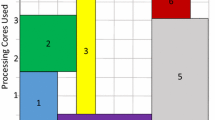Abstract
Many resources such as supercomputers, legal advisors, and university classrooms are shared by many members of an organization. When the supply of shared resources is limited, conflict usually results between contending demanders. If these conflicts can be adequately resolved, then value is created for the organization. In this paper we use the methodology of applied mechanism design to examine alternative processes for the resolution of such conflicts for a particular class of scheduling problems. We construct a laboratory environment, within which we evaluate the outcomes of various allocation mechanisms. In particular, we are able to measure efficiency, the value attained by the resulting allocations as a percentage of the maximum possible value. Our choice of environment and parameters is guided by a specific application, the allocation of time on NASA's Deep Space Network, but the results also provide insights relevant to other scheduling and allocation applications. We find (1) experienced user committees using decision support algorithms produce reasonably efficient allocations in lower conflict situations but perform badly when there is a high level of conflict between demanders, (2) there is a mechanism, called the Adaptive User Selection Mechanism (AUSM), which charges users for time and yields high efficiencies in high conflict situations but, because of the prices paid, in which the net surplus available to the users is less than that resulting from the inefficient user committee (a reason why users may not appreciate ‘market solutions’ to organization problems) and (3) there is a modification of AUSM in which tokens, or internal money, replaces real money, which results in highly efficient allocations without extracting any of the users' surplus. Although the distribution of surplus is still an issue, the significant increase in efficiency provides users with a strong incentive to replace inefficient user committees with the more efficient AUSM.
Similar content being viewed by others
References
Banks, J., J. Ledyard and D. Porter, 1989, Allocating uncertain and unresponsive resources: An experimental approach, RAND Journal of Economics 20, 1–25.
Bykowsky, M., R. Cull and J. Ledyard, 1995, Mutually destructive bidding: The FCC auction design problem, Social science working paper no. 916 (California Institute of Technology, Pasadena, CA)
Calsamiglia, X., 1977, Decentralized resource allocation and increasing returns, Journal of Economic Theory 14, 263–283.
Grether, D., R.M. Isaac and C. Plott, 1981, The allocation of landing rights by unanimity among competitors, American Economic Review, Proceedings, 71, 166–171.
Hurwicz, L., 1994, Economic design, adjustment processes, mechanisms and institutions, Economic Design 1, 1–14.
Jordan, J., 1987, informational requirements of local stability in decentralized allocation mechanisms, In: T. Groves, R. Radner and S. Reiter, eds., Information, incentives and economic mechanisms (University of Minnesota Press, Minneapolis, MN) Ch. 5.
Koopmans, T. and M. Beckman, 1957, Assignment problems and the location of economic activities, Econometrica 25, 53–76.
Ledyard, J., 1993, The design of coordination mechanisms and organizational computing, Journal of Organizational Computing 3, 121–134.
Ledyard, J., 1995, Public goods: A survey of experimental research, In: A. Roth and J. Kagel, eds., Handbook of experimental economics (Princeton University Press, Princeton, NJ).
Ledyard, J., C. Noussair and D. Porter, 1994, The allocation of a shared resource within an organization, Working paper 1063 (Krannert School of Management, Purdue University, West Lafayette, IN).
Olson, M., 1991, Dominant and Nash strategy mechanisms for the assignment problem, Social science working paper no. 770 (California Institute of Technology, Pasadena, CA).
Olson, M. and D. Porter, 1991, A deep space resource allocation primer, Mimeo. (california Institute of Technology, Pasadena, CA).
Olson, M. and D. Porter, 1994, An experimental examination into the design of decentralized methods to solve the assignment problem with and without money, Economic Theory 4, 11–40.
Papai, S., 1994, Assignment by design, Mimeo. (California Institute of Technology, Pasadena, CA).
Riker, W. and I. Sened, 1991, A political theory of the origin of property rights: Airport slots, American Journal of Political Science 35, 951–969.
Saari, D. and C. Simon, 1978, Effective price mechanisms, Econometrica 46, 1097–1125.
Smith, V., 1976, Experimental economics: Induced value theory, American Economic Review 66, 274–279.
Author information
Authors and Affiliations
Rights and permissions
About this article
Cite this article
Ledyard, J.O., Noussair, C. & Porter, D. The allocation of a shared resource within an organization. Economic Design 2, 163–192 (1996). https://doi.org/10.1007/BF02499132
Received:
Issue Date:
DOI: https://doi.org/10.1007/BF02499132




